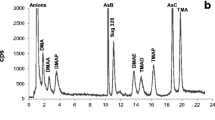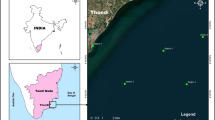Abstract
A three-organism food chain within a rock pool at Rosedale, NSW, Australia, was investigated with respect to arsenic compounds by high performance liquid chromatography – hydraulic high pressure nebulization – inductively coupled plasma mass spectrometry (HPLC-HHPN-ICP-MS). Total arsenic concentration was determined in the seaweed Hormosira banksii (27.2 μg/g dry mass), in the gastropod Austrocochlea constricta (74.4 μg/g dry mass), which consumes the seaweed, and in the gastropod Morula marginalba (233 μg/g dry mass), which eats Austrocochlea constricta. The major arsenic compounds in the seaweed were (2′R)-dimethyl[1-O-(2′,3′-dihydroxypropyl)-5-deoxy-β-d-ribofuranos-5-yl]arsine oxide and an unidentified compound. The herbivorous gastropod Austrocochlea constricta transformed most of the arsenic taken up with the seaweed to arsenobetaine. Traces of arsenite, arsenate, dimethylarsinic acid, arsenocholine, the tetramethylarsonium cation, and several unknown arsenic compounds were detected. Arsenobetaine accounted for 95% of the arsenic in the carnivorous gastropod Morula marginalba. In Morula marginalba the concentration of arsenocholine was higher, and the concentrations of the minor arsenic compounds lower than in the herbivorous gastropod Austrocochlea constricta.
Similar content being viewed by others

Author information
Authors and Affiliations
Additional information
Received: 18 November 1996 / Revised: 17 February 1997 / Accepted: 18 February 1997
Rights and permissions
About this article
Cite this article
Goessler, W., Maher, W., Irgolic, K. et al. Arsenic compounds in a marine food chain. Fresenius J Anal Chem 359, 434–437 (1997). https://doi.org/10.1007/s002160050605
Issue Date:
DOI: https://doi.org/10.1007/s002160050605



